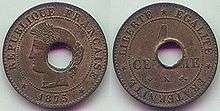Cochinchina piastre



Between 1878 and 1885, the Cochinchina piastre was the currency of the French colony of Cochinchina. It was replaced by the French Indochinese piastre after the creation of a unified administration for Cochinchina and the other French protectorates and colonies in the Far East (Annam, Cambodia and Tonkin) on 22 December 1885.
Economics
Up to 1878, French colonies used the French franc, which was then on the gold standard. The monetary policies of Cochinchina, however, had to balance the needs of trade with France and other Europeans against the needs of trade in Asia, where the silver standard predominated. To this end France introduced the piastre in Cochinchina, which was based on the silver standard and was not tied to the French franc. This set Cochinchina, and after 1885 other French colonies in Indo-China, apart from French colonies in Africa and the Pacific, which did not have currencies independent of the French franc until the CFA franc and the CFP franc were introduced after the Second World War.[1]
Coins
1878: Copper Sapeque (1/1000 Piastre) Bordeaux Mint, holed in Saigon arsenal.
1879: Copper Sapeque (1/500 Piastre), 1 Cent; Silver 10 Cents, 20 Cents, 50 Cents, 1 Piastre (Essai) Paris Mint
1884: Copper 1 Cent; Silver 10 Cents, 20 Cents, 50 Cents. Paris Mint
1885: All denominations were minted in PROOF quality in limited quantity.
The sapeque was the French colonial version of the cash[2] Like the Chinese cash, which the French allowed the local Nguyen emperors to continue imitating, it has a square hole and only inscriptions for its types. Now, the inscriptions are in both French and Vietnamese (written with Chinese characters) and the coins are struck not cast [3] Larger copper centimes and the silver coins of French Cochinchina all showed a seated personification of the Republic from the Great Seal of France. As in the seal, she has her left arm on a rudder and a fasces in her right hand, but now an anchor is placed behind the rudder and there are rice plants in the background. Jacques-Jean Barre engraved the seal and his son A. Barre designed this coin. His name, BARRE, appears below the personification’s foot. The A mint mark of Monnaie de Paris appears on these coins along with the marks of its master and chief engraver, which changed between the beginning and end of the issue.[4]
Banknotes
The banknotes of 5, 20 and 100 Dollars/Piastres, issued by the Banque de l'Indochine and similar in design to later French Indochina notes, are currently extremely rare.
References
- Howard A. Daniel, III (1978) The Catalog and Guidebook of Southeast Asian Coins and Currency. Volume I: France. ISBN 0-931960-01-0
- Jean Lecompte (2000) Monnaies et Jetons des Colonies Françaises. ISBN 2-906602-16-7
- ↑ Jean-Pascal Bassino and Hironobu Nakagawa, Exchange Rates and Exchange Rate Policies in Vietnam Under French Rule, 1878-1945, page 348.
- ↑ R. S. Yeoman, A Catalog of Modern World Coins, page 168 of the 1962 edition
- ↑ Joe Cribb, Barrie Cook and Ian Carradice, The Coin Atlas, pate 215
- ↑ Roger Dewardt Lane, Encyclopedia Small Silver Coins, page 234
External links
| Preceded by: Mexican dollar, Vietnamese cash Reason: decree of January 21, 1875 chartering Banque de l'Indochine |
Currency of French Cochincnina 1878 – 1885 |
Succeeded by: French Indochina Piastre Reason: creation of French Indochina Ratio: at par |